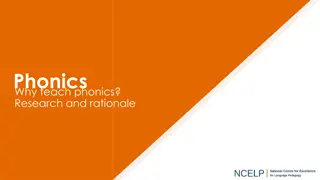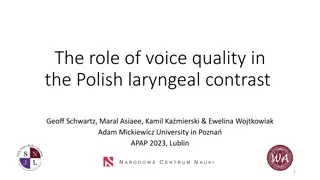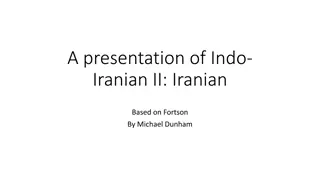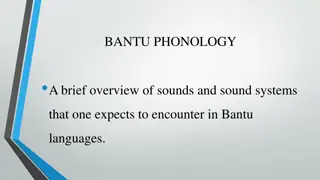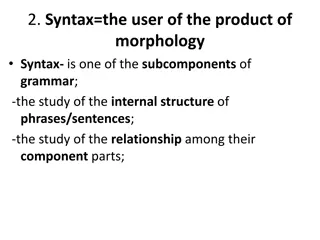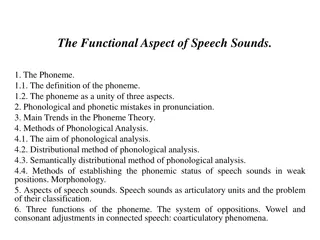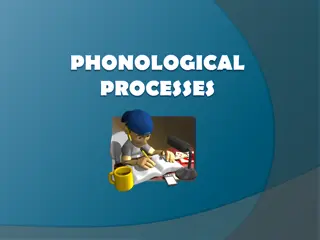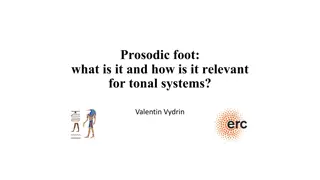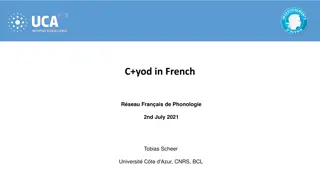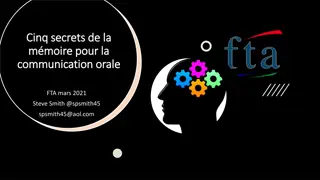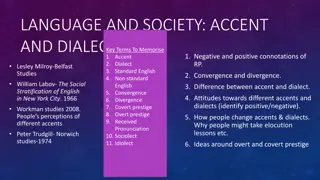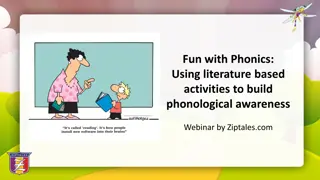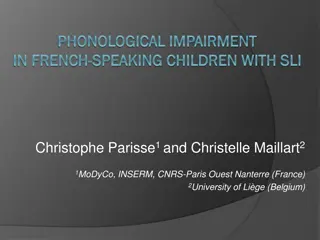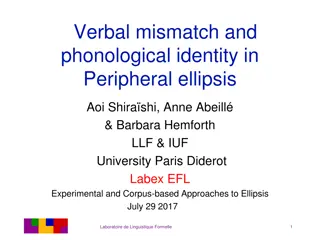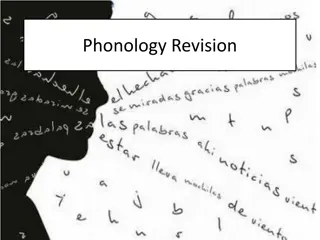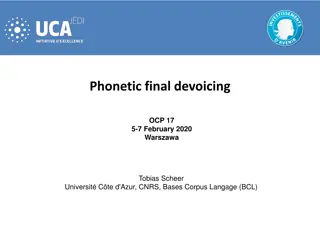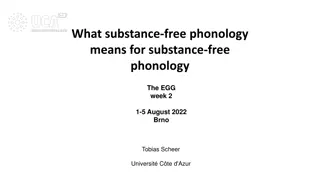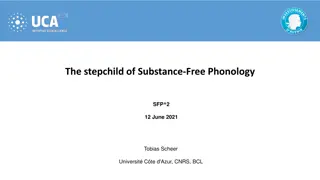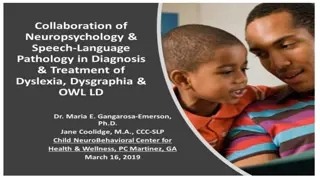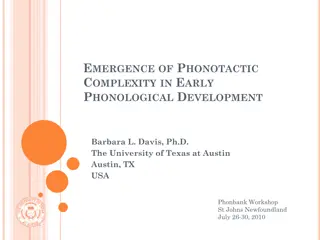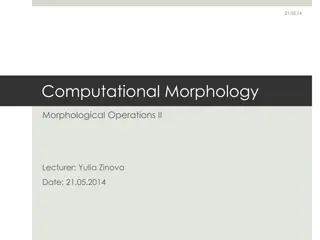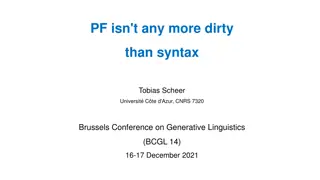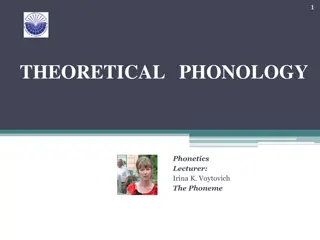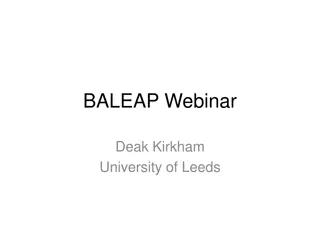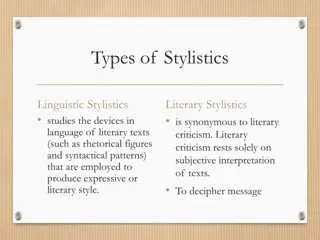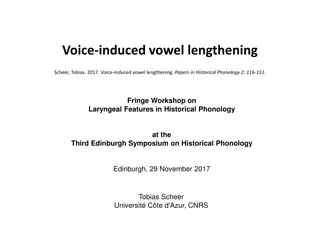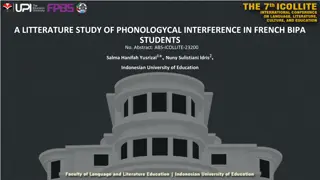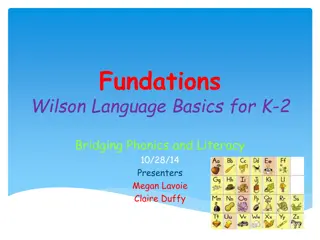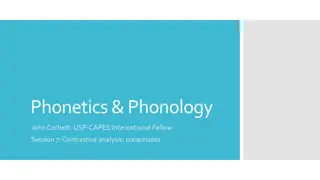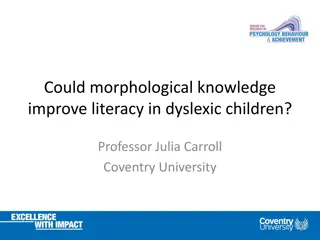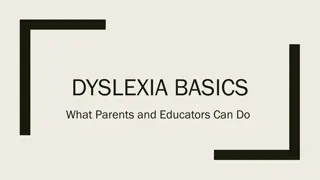Understanding English Syllables: Structure and Description
Explore the concept of syllables in English phonetics through an in-depth analysis of syllabic structure, sonority, constituents, rhyme, nucleus, coda, and phonological perspectives. Delve into the definition of a syllable, its importance in speech production, and the phonetic descriptions of syllab
2 views • 38 slides
Phonics. Why teach phonics?. Research and rationale.
Teaching phonics, the relationship between letters and sounds, is essential in language learning to improve reading skills. This content explores the significance of phonics instruction, its effectiveness in L2 learning, and the role of phonological decoding. It also discusses the importance of accu
2 views • 33 slides
Linguistics: Exploring Language Structure and Morphology
Linguistics is the scientific study of language and speech, encompassing branches like phonology, lexicology, and morphology. This field delves into the levels of language structure, such as phonological, morphological, lexical, syntactic, semantical, pragmatical, and stylistical. Scholars began inv
8 views • 7 slides
Voice Quality in Polish Laryngeal Contrast
Examining the role of voice quality in the laryngeal contrast of Polish, this research delves into the phonological complexities and perceptions of voice contrasts in the Polish language. It compares traditional binary approaches to newer unary approaches, discussing implications and challenges in r
0 views • 28 slides
Overview of Iranian Languages: A Linguistic Analysis Based on Fortson
Iranian languages, divided into Old, Middle, and Modern branches, exhibit distinct phonological and morphological features compared to Indic languages. The presentation explores differences in Iranian phonology, including deaspiration of voiced aspirates and spirantization of voiceless stops, and ex
0 views • 9 slides
Exploring Bantu Phonology and Linguistic Classification
Delve into the intriguing world of Bantu phonology and linguistic classification, covering the diverse sounds and phonological processes found in Bantu languages. Discover the rich heritage of over 500 Bantu languages in sub-Saharan Africa, classified into zones and classes, shedding light on the fa
0 views • 38 slides
Understanding Syntax and Grammar Components
Syntax is a vital subcomponent of grammar that involves studying the internal structure and relationship of phrases and sentences. Grammar components include Lexicon/Vocabulary, Phonological Form, Syntactic component/Grammar, and Logical Form. Constituents are parts that combine to form a whole stru
2 views • 40 slides
Enhancing Literacy Skills Through Educational Jeoparody Game
Explore a fun and informative educational Jeoparody game designed to boost literacy skills in children. Categories like Phonological Awareness, Vocabulary, and Print Knowledge challenge participants in a dynamic learning environment. From identifying letter names to understanding print concepts, thi
1 views • 47 slides
Understanding the Functional Aspect of Speech Sounds
The functional aspect of speech sounds delves into the concept of phonemes, phonological and phonetic mistakes in pronunciation, main trends in the phoneme theory, and methods of phonological analysis. It explores the definition of phonemes, the three aspects of phonemes, and the different views on
0 views • 30 slides
Understanding Phonological Processes in English Language
Phonological processes involve changes in linguistic sounds over time, impacting language fluency and oral production significantly. EFL students can benefit from knowledge of these processes, like linking, gemination, elision, metathesis, assimilation, haplology, and coalescence, to enhance their l
0 views • 17 slides
The Great Vowel Shift: A Linguistic Evolution
The Great Vowel Shift was a significant phonological transformation in the English language during the 15th to 17th centuries that altered the pronunciation of long vowel sounds. This shift, marked by a movement of vowel sounds to higher and more forward positions in the mouth, shaped the transition
3 views • 11 slides
Understanding Prosodic Foot and Its Relevance in Linguistics
The prosodic foot is a vital unit in linguistic analysis associated with stress and word prominence. It serves as an intermediary between syllables and words, influencing tonal systems and phonological structures through patterns like metrical parsing and foot-headedness. Language-specific manifesta
11 views • 20 slides
French Phonology Study: C+yod in French Représentation
Research conducted by Tobias Scheer on 2nd July 2021 at Université Côte d'Azur, CNRS, BCL examines the occurrence of C+yod in French phonology. The study identifies specific patterns where C+yod occurs, emphasizing morphological boundaries and differentiating between lexical origins of the yod. Fu
0 views • 35 slides
Enhancing Oral Communication Skills: 5 Memory Secrets for Effective Speaking
Explore five key memory secrets for improving oral communication skills, including the role of repetition, implicit versus explicit learning, chunking techniques, preventing forgetting, and strategies for retrieval and fluency building. Discover how visuals, rehearsal activities, and activating the
0 views • 32 slides
Understanding Language Variation and Social Identity
Language and society are intricately connected through accent, dialect, standard English, and non-standard English. The concepts of convergence, divergence, covert prestige, and overt prestige influence how identity is formed. This text delves into regional dialects and accents, highlighting the dif
2 views • 63 slides
Exploring Grammar and Phonics in the Victorian Curriculum
This insightful discussion delves into the integration of grammar and phonics in the Victorian Curriculum, offering practical approaches for educators. It explores the importance of phonics, phonemic awareness, and sound-letter knowledge in language development. The content emphasizes the value of u
0 views • 37 slides
Exploring Phonological Awareness Through Literature-Based Activities
Explore the importance of phonological awareness in decoding written text and discover how literature-based activities can enhance phonemic and syllabic skills in students. The curriculum references from Australia and New Zealand highlight the significance of sound-letter associations. Embrace a lit
0 views • 34 slides
Phonological Impairment in French-speaking Children with SLI: Evidence and Origins
This study explores phonological impairment in French-speaking children with SLI, confirming specific difficulties in phonology compared to age-matched peers and across different languages. Evidence suggests phonological delays and deficits, with stronger evidence found through comparison with MLU-m
0 views • 50 slides
Verbal Mismatch and Phonological Identity in Peripheral Ellipsis
The study delves into verbal mismatch and phonological identity in peripheral ellipsis, covering topics such as syntactic mismatches, peripheral ellipsis and mismatch, and stricter identity requirements in peripheral ellipsis compared to other types of ellipsis. Various examples and analyses are pre
0 views • 49 slides
Understanding Phonology Concepts in Language Learning
Phonology is the study of sounds in language and how they are produced. This content explores the production of sounds, types of sounds like plosives and fricatives, common phonological errors, and the "fis" phenomenon. It also discusses term deletion, exemplified by omission, substitution, addition
0 views • 13 slides
Understanding Phonetic Final Devoicing and Its Implications in Phonological Theory
Phonetic Final Obstruent Devoicing (FOD) challenges traditional phonological theories by presenting instances where devoicing cannot be purely phonological but must be phonetic in nature. This phenomena is evident in Proto- and Old French where word-final consonants devoice despite having intervocal
0 views • 30 slides
Understanding Substance-Free Phonology and Its Implications
Substance-free phonology, as discussed by Tobias Scheer, explores the distinction between phonologically meaningful and meaningless items, highlighting their production and phonetic correlates. The article emphasizes the non-arbitrary nature of meaningful items and the arbitrary interchangeability o
0 views • 30 slides
Exploration of Substance-Free Phonology and Phonological Theory
This text delves into the concept of substance-free phonology, discussing the arbitrariness of phonological items, the distinction between phonologically meaningful and meaningless items, and the relationship between phonology and phonetics. It also explores the role of sonority in phonological theo
0 views • 11 slides
English Loanwords in Japanese: Adaptation and Evolution
Explore the fascinating journey of English loanwords in Japanese, from phonological changes to acronym creation, abbreviation by clipping, new combination loanword derivation, loanblends, and semantic shifts. Witness how these borrowed words have been transformed to fit the unique syllabic structure
0 views • 8 slides
Exploring the Art of Writing Sonnets and Understanding Iambic Pentameter
Uncover the beauty of sonnets and the significance of iambic pentameter in poetic works. Dive into the rhythmic structure, syllables, and poetic meter, discovering the allure and impact of writing in iambic pentameter alongside exploring the phonological intricacies of syllables.
0 views • 25 slides
Understanding Dysgraphia, Dyslexia, and OWLLD
Dysgraphia, dyslexia, and oral and written language learning disability (OWLLD) are distinct learning challenges affecting different areas of language processing. Dysgraphia primarily impacts spelling and handwriting due to motor memory and visual spelling issues. Dyslexia involves difficulties in p
0 views • 8 slides
Emergence of Phonotactic Complexity in Early Phonological Development
Barbara L. Davis, Ph.D., from The University of Texas at Austin, presents research on phonotactic complexity in early phonological development using the Texas Speech Production (TSP) database. The study examines the emergence of phonotactic properties in speech acquisition among typically developing
0 views • 39 slides
Morphological Operations in Computational Linguistics
Explore different morphological operations in computational linguistics, including phonological changes induced by affixation in German, subsegmental morphology in Irish, and subtractive morphology in Koasati. Transducers and examples are provided to illustrate the transformations involved in each p
0 views • 12 slides
Exploring Minimalism in Linguistics: Dirty PF and Clean Syntax
This text delves into the relationship between syntax and PF (Phonological Form) in the context of minimalism theory in linguistics. It discusses how minimalism aims to achieve clean syntax by discarding imperfect elements, with PF often considered as "dirty" due to its association with phonology. T
0 views • 40 slides
Introduction to Theoretical Phonology: Understanding Phonemes and Speech Sounds
The lecture explores the fundamental concepts of phonology, focusing on phonemes, speech sounds, phonological theories, and their historical background. It delves into the functions of phonemes in forming language units, distinguishing words, and their connection to meaning. Various theories and fun
0 views • 43 slides
Understanding Glottalisation of /t/ in English Phonology
Exploring the phonological process of glottalisation affecting the /t/ sound in English, focusing on intervocalic environments and beyond. The case study delves into word-final and word-medial positions, highlighting nuances in pronunciation and teaching points for syllable stress and articulation c
0 views • 13 slides
Understanding Linguistic and Literary Stylistics
Linguistic Stylistics explores devices in language of literary texts to create expressive styles. Literary criticism relies on subjective interpretation, while Stylistic Analysis in linguistics identifies patterns in speech and writing. This content delves into the phonological, graphological, and l
0 views • 17 slides
Understanding Phonetic and Phonological Properties of Voicing in Polish Language
Explore the phonetic and phonological aspects of voicing in the Polish language, including the representation of contrasts, laryngeal distributions, and processes like neutralization and assimilation. Dive into topics like final obstruent devoicing, two-way voicing contrast, and the role of sonorant
0 views • 40 slides
Enhancing Literacy Instruction with Explicit Strategies
Explicit instruction is a direct, clear, and effective teaching approach that empowers students to learn independently. This method emphasizes structured guidance, practice, and feedback to ensure comprehension and skill development. Cognitive planning focuses on critical content and big ideas, such
0 views • 13 slides
Voice-Induced Vowel Lengthening in Phonology Research
Exploring the phenomenon of voice-induced vowel lengthening, this research delves into spontaneous vs. non-spontaneous voicing patterns and the documented transmission of voicing from vowels/sonorants to voiceless obstruents. The study discusses various theories on voice transmission from sonorants/
2 views • 35 slides
Phonological Interference in French BIPA Students: A Literature Study
BIPA students face challenges in pronunciation due to phonological interference, especially in French-speaking students. This study explores the linguistic aspects contributing to pronunciation errors and proposes phonetic corrections. Literature review discusses language interference and factors in
0 views • 11 slides
Fundations: Building Blocks for Early Literacy Success
Fundations is a comprehensive language program designed for K-2 students with varying learning abilities. It focuses on phonics, multisensory techniques, skill development, and extensive practice to foster reading and spelling skills. With a scope and sequence approach, Fundations teaches phonologic
0 views • 11 slides
Comparative Analysis of Consonants in English and Brazilian Portuguese
Explore the differences in consonant pronunciation between English and Brazilian Portuguese, focusing on minimal pairs and potential confusion points. The session covers various aspects such as vowel systems, phonological challenges, and accent nuances that may arise for Portuguese speakers when spe
0 views • 25 slides
Exploring the Impact of Morphological Knowledge on Literacy in Dyslexic Children
Understanding morphology and its role in literacy development among dyslexic children is crucial. This study delves into the relationship between morphological awareness, phonological difficulties, and literacy success. It also investigates the effectiveness of morphological approaches in supporting
0 views • 41 slides
Understanding Dyslexia: What Parents and Educators Can Do
Dyslexia is a specific learning disability of neurobiological origin, characterized by difficulties in word recognition, spelling, and decoding. It stems from a deficit in the phonological component of language, impacting reading comprehension and vocabulary growth. Proper support and effective clas
0 views • 21 slides

